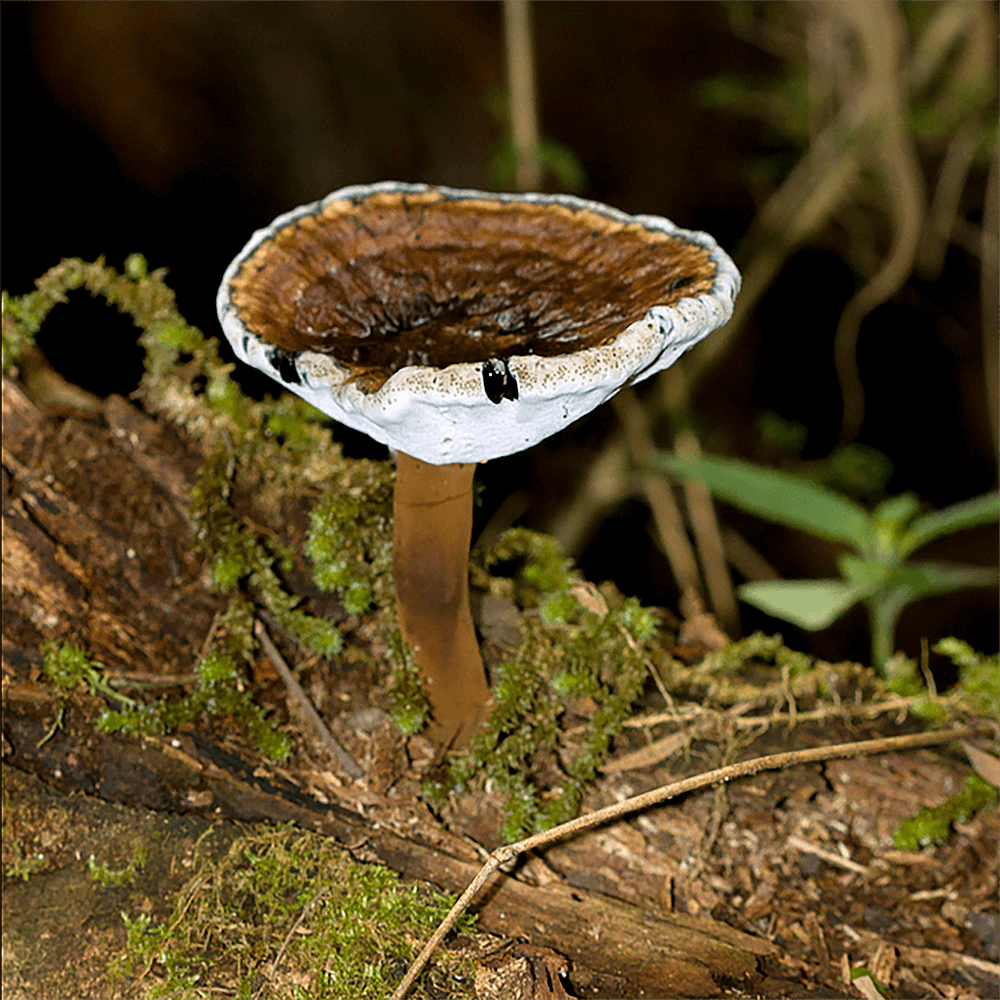Description
What is the Red-Staining Polypore?
The Red-Staining Polypore (Amauroderma rude) is a striking and unusual polypore mushroom known for its dramatic bruising reaction — when the white flesh is touched or damaged, it stains deep blood-red to almost black within seconds. This vivid change makes it one of the most visually distinct wood-decaying fungi in the world.
Although not edible due to its tough texture and unknown edibility profile, it is highly valued for mycological study, biodiversity displays, and ecological research.
Where Does Amauroderma rude Grow?
Amauroderma rude is most commonly found in tropical and subtropical forests across Australia and Southeast Asia, where it grows at the base of hardwood trees or directly from buried wood. It typically fruits during the rainy season and thrives in nutrient-poor, sandy soils or heavily decayed woody debris.
Its presence in forest ecosystems marks it as an important player in long-term wood decomposition and fungal succession processes.
Unique Characteristics and Study Potential
A Rare Mushroom That Bruises Blood-Red
The fruiting body of Amauroderma rude features a thick, woody stem with a pale to dark brown cap that becomes nearly black with age. The most remarkable feature is the white pore surface on the underside — when scratched, bruised, or even lightly handled, it stains instantly red, then darkens as the pigments oxidize.
This reaction has made it a subject of interest in fungal chemistry and pigmentation research. It is also frequently used in educational demonstrations and fungal identification exercises.
Ideal for Research, Education, and Culture Collections
This species is not cultivated for culinary or medicinal use, but it is highly desirable for labs, naturalists, and serious collectors. Its slow-growing mycelium colonizes woody materials and is best suited to sterilized hardwood chips, sawdust blocks, or agar plates for long-term observation.
This 12cc liquid culture syringe contains clean, healthy Amauroderma rude mycelium, ready for propagation in controlled lab or grow-room conditions.
Order Your Red-Staining Polypore Liquid Culture Today
Explore one of the most visually fascinating fungi with this liquid culture of Amauroderma rude. A must-have for educators, biodiversity enthusiasts, and fungal chemists studying color reactions and ecological behavior.
Taxonomic Details for Amauroderma rude
-
Kingdom: Fungi
-
Division: Basidiomycota
-
Class: Agaricomycetes
-
Order: Polyporales
-
Family: Ganodermataceae
-
Genus: Amauroderma
-
Species: Amauroderma rude
Red-Staining Polypore (Amauroderma rude)
Product Overview
Key Features
Usage Instructions
Storage Recommendations
Cultivation and Educational Value
Safety Information
Environmental and Sustainability Notes
Disclaimer
Description
What is the Red-Staining Polypore?
The Red-Staining Polypore (Amauroderma rude) is a striking and unusual polypore mushroom known for its dramatic bruising reaction — when the white flesh is touched or damaged, it stains deep blood-red to almost black within seconds. This vivid change makes it one of the most visually distinct wood-decaying fungi in the world.
Although not edible due to its tough texture and unknown edibility profile, it is highly valued for mycological study, biodiversity displays, and ecological research.
Where Does Amauroderma rude Grow?
Amauroderma rude is most commonly found in tropical and subtropical forests across Australia and Southeast Asia, where it grows at the base of hardwood trees or directly from buried wood. It typically fruits during the rainy season and thrives in nutrient-poor, sandy soils or heavily decayed woody debris.
Its presence in forest ecosystems marks it as an important player in long-term wood decomposition and fungal succession processes.
Unique Characteristics and Study Potential
A Rare Mushroom That Bruises Blood-Red
The fruiting body of Amauroderma rude features a thick, woody stem with a pale to dark brown cap that becomes nearly black with age. The most remarkable feature is the white pore surface on the underside — when scratched, bruised, or even lightly handled, it stains instantly red, then darkens as the pigments oxidize.
This reaction has made it a subject of interest in fungal chemistry and pigmentation research. It is also frequently used in educational demonstrations and fungal identification exercises.
Ideal for Research, Education, and Culture Collections
This species is not cultivated for culinary or medicinal use, but it is highly desirable for labs, naturalists, and serious collectors. Its slow-growing mycelium colonizes woody materials and is best suited to sterilized hardwood chips, sawdust blocks, or agar plates for long-term observation.
This 12cc liquid culture syringe contains clean, healthy Amauroderma rude mycelium, ready for propagation in controlled lab or grow-room conditions.
Order Your Red-Staining Polypore Liquid Culture Today
Explore one of the most visually fascinating fungi with this liquid culture of Amauroderma rude. A must-have for educators, biodiversity enthusiasts, and fungal chemists studying color reactions and ecological behavior.
Taxonomic Details for Amauroderma rude
-
Kingdom: Fungi
-
Division: Basidiomycota
-
Class: Agaricomycetes
-
Order: Polyporales
-
Family: Ganodermataceae
-
Genus: Amauroderma
-
Species: Amauroderma rude



